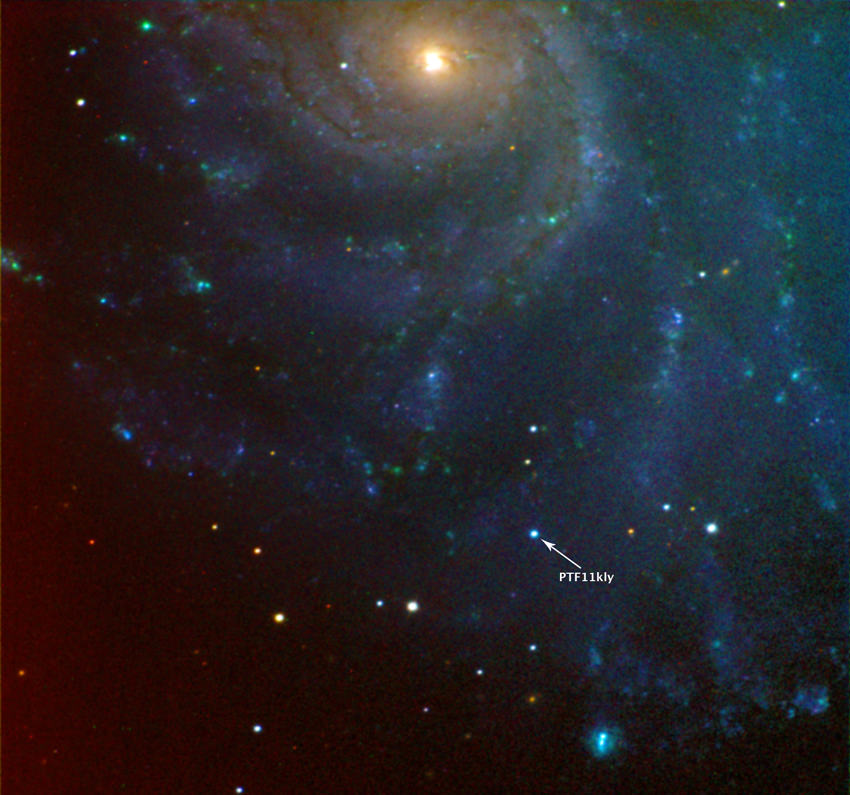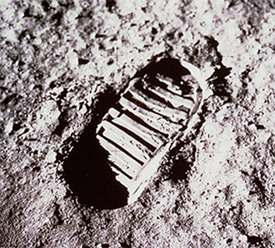Just what will the GRAIL mission to the Moon do? Find out in just over 3 minutes with this new video about the mission. The launch of GRAIL is scheduled for Sept. 8, 2011 from Cape Canaveral Air Force Station in Florida.
Looking at Uranus
Go ahead, take a second for your mind to empty of all the bad puns about the title of this story. Then, watch this great video from YouTuber Thunderf00t. It’s an amazing timelapse video of the night sky, including images of Uranus and its moons.
Shiny New Supernova Spotted in Nearby Galaxy
[/caption]
Literally an event of stellar proportions, a new Type Ia supernova has been identified in a spiral galaxy 25 million light-years away! Spotted by Caltech’s Palomar Transit Factory project, this supernova, categorized as PTF11kly, is located 58″.6 west and 270″.7 south of the center of M101. It was first seen yesterday, August 24, 2011.
According to AAVSO Special Notice #250 P. Nugent et al. reported in Astronomical Telegram #3581 that a possible Type-Ia supernova has been discovered by the Palomar Transient Factory shortly after eruption in the galaxy M101 and has been designated “PTF11kly”. The object is currently at a magnitude of 17.2, but may well rise by several magnitudes. The object is well placed within M101 for good photometry, and observations of this potential bright SNIa are strongly encouraged.
There are currently no comparison stars available in VSP for this field; please indicate clearly the comparison stars that you use for photometry when reporting observations to AAVSO. Please retain your images and/or photometry for recalibration when comparison star magnitudes are available.
Need coordinates? The (J2000) coordinates reported for the object are RA: 14:03:05.81 , Dec: +54:16:25.4. Messier 101 is located in the constellation of Ursa Major at RA: 14h 03m 12.6s Dec: +54 20′ 57″
Charts for PTF11kly may be plotted with AAVSO VSP. You should select the DSS option when plotting, as the galaxy will not appear on standard charts. This object has been assigned the name “PTF11kly” for use with AAVSO VSP and WebObs; please use this name when reporting observations until it is conclusively classified as a supernova and a proper SN name is assigned.
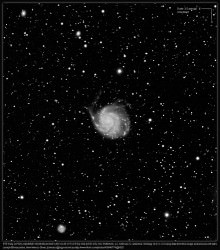
Type Ia supernovae are the result of a binary pair of mismatched stars, the smaller, denser one feeding on material drawn off its larger companion until it can no longer take in any more material. It then explodes in a catastrophic event that outshines the brightness of its entire galaxy! Astronomers believe that Type Ia supernovae occur in pretty much the same fashion every time and thus, being visible across vast distances, have become invaluable benchmarks for measuring distance in the Universe and gauging its rate of expansion.
The fact that this supernova was spotted literally within a day of its occurrence – visibly speaking, of course, since M101 is 25 million light-years away and thus 25 million years in our past – will be extremely handy for astronomers who will have the opportunity to study the event from beginning to end and learn more about some of the less-understood processes involved in Type Ia events.
“We caught this supernova earlier than we’ve ever discovered a supernova of this type. On Tuesday, it wasn’t there. Then, on Wednesday, boom! There it was – caught within hours of the explosion. As soon as I saw the discovery image I knew we were onto something big.”
– Andy Howell, staff scientist at Las Cumbres Observatory Global Telescope
It’s a big Universe and there are a lot of stars and therefore a lot of supernovae, but getting a chance to study one occurring so recently in a galaxy so relatively close to our own is something that is getting many astronomers very excited.
So, get those CCD camera out and best of luck!
Keep up with the latest news on PTF11kly on the rochesterastronomy.org site, and check out Phil Plait’s informative article on his BadAstronomy blog. Also read the press release from the University of California here.
Tammy Plotner also contributed to this article.
_________________________
Jason Major is a graphic designer, photo enthusiast and space blogger. Visit his website Lights in the Dark and follow him on Twitter @JPMajor and on Facebook for more astronomy news and images!
When Do You Think Humans Will Return to the Moon?
[/caption]
We’re conducting a completely informal, unscientific, off-the-cuff survey of Universe Today readers. When do you think that humans will return to the Moon?
Just give us your responses in the comments. We’re thinking of pulling your answers together to try and wrangle the zeitgeist about human space exploration.
Star Transforms Into A Diamond Planet
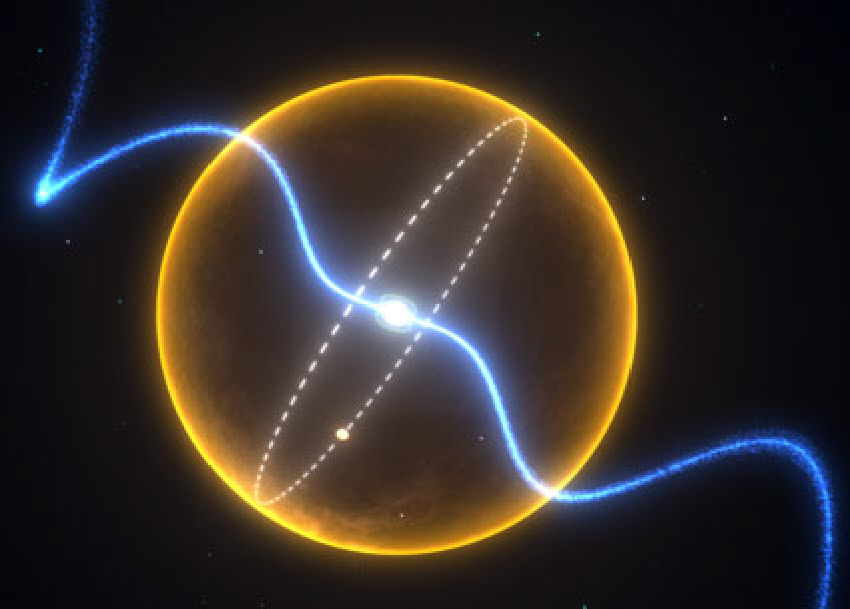
[/caption]
“Remember when you were young… You shone like the sun.” Four thousand light years away in the constellation of Serpens, a millisecond pulsar binary is pounding out its heartbeat. Meanwhile an international research team of scientists from Australia, Germany, Italy, the UK and the USA, including Prof. Michael Kramer from Max Planck Institute for Radio Astronomy in Bonn, German are listening in. Utilizing the 64-m radio telescope in Parkes, Australia, the team made a rather amazing discovery. The companion star could very well be an ultra-low mass carbon white dwarf… one that’s transformed itself into a planet made of pure diamond.
“The density of the planet is at least that of platinum and provides a clue to its origin”, said the research team leader, Prof. Matthew Bailes of Swinburne University of Technology in Australia. Bailes leads the “Dynamic Universe” theme in a new wide-field astronomy initiative, the Centre of Excellence in All-sky Astrophysics (CAASTRO). He is presently on scientific leave at Max Planck Institute for Radio Astronomy.
Like a lighthouse, PSR J1719-1438 emits radio signals which sweep around methodically. When researchers noticed a specific modulation every 130 minutes, they realized they were picking up a signature of planetary proportions. Given the distance of its orbit, the companion could very well be the core of a once massive star whose material was consumed by pulsar’s gravity.
“We know of a few other systems, called ultra-compact low-mass X-ray binaries, that are likely to be evolving according to the scenario above and may likely represent the progenitors of a pulsar like J1719-1438” said Dr. Andrea Possenti, of INAF-Osservatorio Astronomicodi Cagliari.
With almost all of its original mass gone, very little of the companion could be left save for carbon and oxygen… and stars still rich in lighter elements like hydrogen and helium won’t fit the equation. This leaves a density which could very well be crystalline – and a composition which closely resembles diamond.
“The ultimate fate of the binary is determined by the mass and orbital period of the donor star at the time of mass transfer. The rarity of millisecond pulsars with planet-mass companions means that producing such ‘exotic planets’ is the exception and not the rule, and requires special circumstances”, said Dr. Benjamin Stappers from the University of Manchester.
“The new discovery came as a surprise for us. But there is certainly a lot more we’ll find out about pulsars and fundamental physics in the following years”, concludes Michael Kramer.
Shine on, you crazy diamond…
Original Story Source: Max Planck Institut for Radio Astronomy and Transformation of a Star into a Planet in a Millisecond Pulsar Binary.
Human Mission to an Asteroid: The Orion MPCV
Back in 2007, when the Constellation program to return to the Moon was still the program of record for NASA, a group from Lockheed Martin began investigating how they might be able to use the Orion lunar capsule to send humans on a mission to an asteroid. Originally, this plan — called Plymouth Rock — was just a study to see how an asteroid mission with Orion could possibly serve as a complement to the baseline of Constellation’s lunar mission plans.
Now, it has turned into much more.
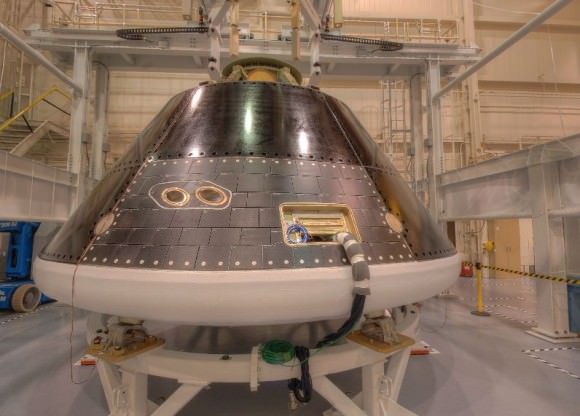
Thanks to John O’Connor from NASATech.net, we are able to show you some views of the Orion MPCV inside Lockheed Martin’s facilities in Boulder, Colorado. If you click on the images, you’ll be taken to the NASATech website and extremely large versions of the images that you can pan around and see incredible details of the MPCV and the building.
After canceling Constellation in February of 2010, two months later President Obama outlined sending astronauts to a nearby asteroid by 2025 and going to Mars by the mid-2030’s.
In May of 2011, NASA confirmed that the centerpiece of those missions will be the Orion – now called the Orion MultiPurpose Crew Vehicle. The repurposed Orion lunar vehicle would now be going to an asteroid, just like Josh Hopkins and his team from Lockheed Martin envisioned in their Plymouth Rock study.
Hopkins is the Principal Investigator for Advanced Human Exploration Missions, a team of engineers who develop plans and concepts for a variety of future human exploration missions.
“Normally when you take a spacecraft or a piece of hardware that has been designed for one job and you try to figure out how to use it for a different job, you discover there are all these details that don’t work out quite right,” Hopkins told Universe Today. “But we were pleasantly surprised that when we took this lunar version of Orion and applied it to an asteroid mission, it is a really flexible and capable vehicle and a lot of the requirements for the lunar mission match pretty well with the asteroid mission.”
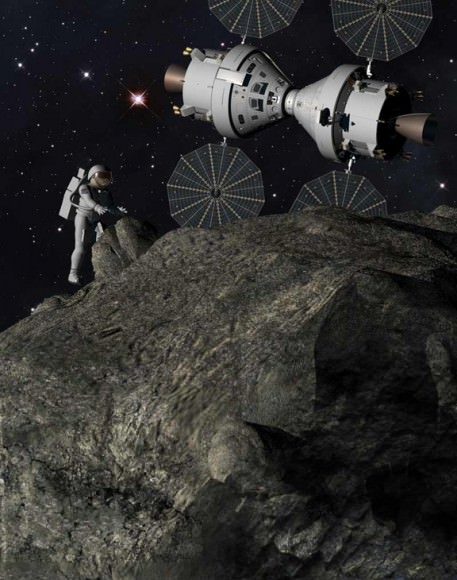
The Plymouth Rock design called for using two specially modified Orion spacecraft docked nose to nose in order to provide enough living space, propulsion, and life-support for two astronauts heading to an asteroid. But NASA has said the MPCV will be used primarily for launch and entry while a larger habitation module would be docked to the MPCV to enable a crew of 4 to travel to deep space.
Shuttle astronaut Tom Jones was impressed with the Plymouth Rock concept, but knows a larger companion vehicle will be needed for a trip to an asteroid. “Plymouth Rock is the minimalist approach to do an asteroid mission,” he said. “That’s one way to solve the redundancy problem in the short-term.”
But even developing an in-space habitat could be a matter of repackaging things we already have. “The hab module could be derived directly from what we’ve done for space station, or it could be a commercial inflatable like from Bigelow, so that might be tried out by a commercial station or hotel in the next 10 years, so that would be demonstrated technology,” Jones said.
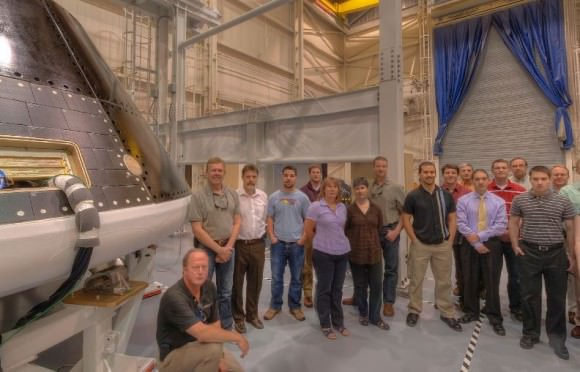
“Basically the tradeoff between a larger in-space habitat module versus the dual Orion approach is that by having a separate habitat you have more living space, more storage space, and there is the potential that it would be better for performing spacewalks,” said Hopkins. “But then you have to invest the costs for developing that system.”
Hopkins added that when he and his team initially conceived the Plymouth Rock mission, they were trying to figure out how to do an asteroid mission for as little as possible. Using two Orions was cheaper than developing a module specific to an asteroid mission.
“For Plymouth Rock, we had spelled out the need to basically increase the amount of food, water, oxygen and storage in the spacecraft, and some of that is accomplished by the fact of having two spacecraft,” Hopkins said.
For now, NASA hasn’t yet changed many of the requirements for the MPCV from what they previously were for the lunar vehicle, and as the mission design evolves, so might the MPCV. But so far, the lunar design seems to be working, and Hopkins said there are several design features already in Orion that make it very capable as a deep space vehicle.
For lunar missions, Orion was designed for basically 21 days with a crew on board going from Earth to the Moon and back and having a roughly have a six month “loiter period” while the crew was down on the lunar surface. That scenario would work for an asteroid mission, as a crewed flight to an asteroid would likely be about a six-month roundtrip journey, depending on the destination.
“So in things like reliability, leak rate of atmosphere in the cabin, and protection from radiation and micrometeorites, Orion is already designed for 6-7 month missions for the hardware,” Hopkins explained. “It is just not designed to have people for that long of time period.”
Orion has solar arrays rather than fuel cells like Apollo, which enable longer missions. Another big selling point is that the MPCV is designed to be 10 times safer during ascent and entry than its predecessor, the space shuttle.
“The reentry speeds are just a little bit faster for an asteroid mission than a lunar mission,” Hopkins said, “but current the thermal protection system we have should be able to handle it.”
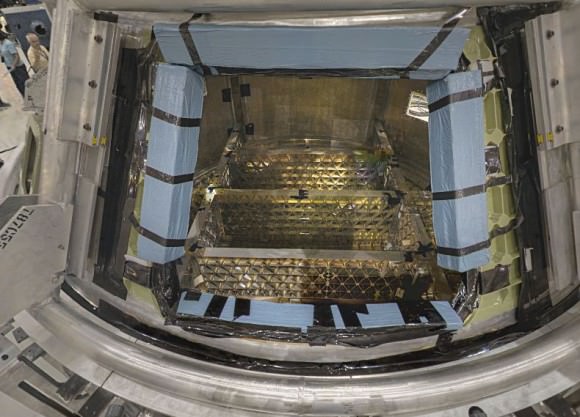
Inside the MPCV is 9 cubic meters of habitable volume. “That is not total pressurized volume of the structure, but the space that’s left after computers, seats, supplies are all accounted for,” said Hopkins. “That’s about twice the size of a modern passenger van, like a Toyota Sienna.”
One big challenge is to figure out how use every nook and cranny to package a lot of supplies in a small amount of space, as the Orion could serve as a storeroom of sorts. “We think it’s possible,” Hopkins said. “We’ve done initial calculations that we can pack a reasonable amount of volume but it would be a pretty tight fit and we also have to think about the secondary things that need to be included, so that’s work that is ongoing.”
Logistically, the Orion MPCV could even support doing an EVA from the hatch on the capsule.
“We have a hatch that is big enough that an astronaut in a space suit can get out,” Hopkins said, “and the internal systems in the spacecraft are designed to tolerate the cabin being depressurized. We don’t rely on air circulation to carry the heat away from the electronics – they have their own cold plates to take the heat away. The knobs are designed to be manipulated with spacesuit gloves on, not just bare hands. A lot of those features just worked out to be pretty applicable to the asteroid mission because it was designed for a similar set of mission requirements.”
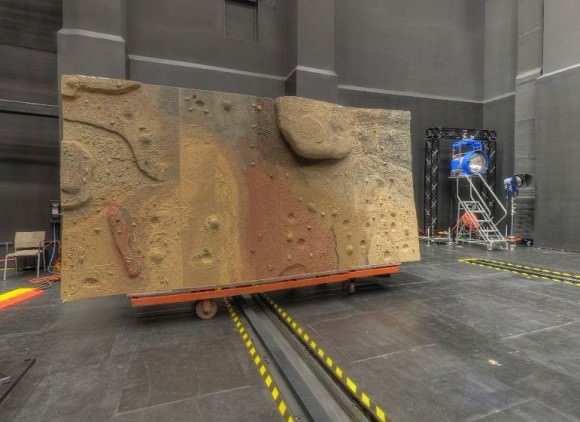
Hopkins knows the requirements and capabilities the Orion, as well as the in-space habitat will likely change over time, depending on the destination and the timeline. “If the plan is to go to the moons of mars or distant asteroids relatively soon, say in the late 2020’s or early 2030s, you might go ahead and build a relatively large, capable in space habitat, because you will definitely need it for those more distant missions. But if the idea were to go to the easiest asteroids to get to and do that relatively soon, then you might stick with a smaller simpler habitat module, or perhaps even the twin Orion approach.”
When the MPCV does return from a mission to an asteroid, it will likely land in the Pacific Ocean. NASA has begun some at NASA’s Langley Research Center to certify the vehicle for water landings. Engineers have dropped a 22,000-pound MPCV mockup into the basin. The test item is similar in size and shape to MPCV, but is more rigid so it can withstand multiple drops. Each test has a different drop velocity to represent the MPCV’s possible entry conditions during water landings.
So while these tests are happening and while Hopkins and his team from Lockheed Martin are working on and testing the Orion MPCV, NASA is still trying to decide on a heavy-lift launch system capable of bringing humans beyond low Earth orbit and they have not named anyone to lead the design of a human mission to an asteroid. The NASA website doesn’t even have any official information about a human asteroid mission; it only mentions “beyond low Earth orbit” as the next stop for humans.
“We’re talking about something that is going to happen in 2025 so we haven’t even decided on a spacecraft yet,” said Michael Braukus from NASA’s Exploration Systems Mission Directorate via a phone call. “We’re planning on the asteroid mission happening; it’s just that we haven’t designated a person to be responsible for the asteroid mission itself. We have the Orion MPCV under construction and we are awaiting on the decision of a space launch system, which will be the rocket that will carry it to deep space, and we’re progressing down the road, but haven’t reached a point yet where we have actually assigned someone to start developing the mission.”
So, that appears to be NASA’s current biggest hurdle to a human asteroid mission: deciding on the Space Launch System.
Previous article in this series: Human Mission to an Asteroid: Why Should NASA Go?
You can follow Universe Today senior editor Nancy Atkinson on Twitter: @Nancy_A. Follow Universe Today for the latest space and astronomy news on Twitter @universetoday and on Facebook.
Microfossils Discovered On Earth Could Aid In Finding Ancient Life On Mars
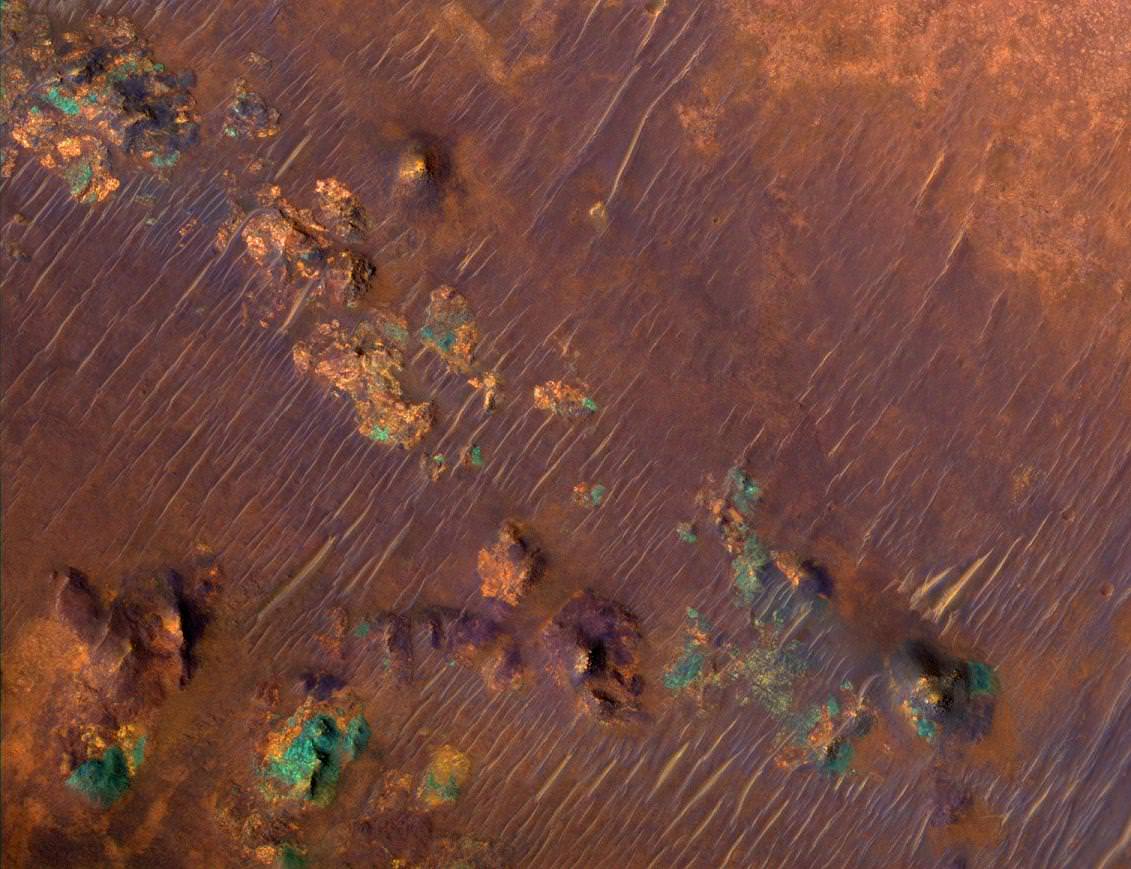
[/caption]
What does a more than three billion year old sandstone formation in Western Australia have in common with Mars? The Aussie stones contain the oldest living microbial record of life on Earth – and it might be the basis of fossil discovery on Mars. The early Archaean rocks are providing geologists with microfossil evidence that early life might have been utilizing sulpher – instead of oxygen – for their ecosystems.
“At last we have good solid evidence for life over 3.4 billion years ago. It confirms there were bacteria at this time, living without oxygen,” said co-researcher Professor Martin Brasier at Oxford University, UK. “Such bacteria are still common today. Sulphur bacteria are found in smelly ditches, soil, hot springs, hydrothermal vents – anywhere where there’s little free oxygen and they can live off organic matter,” he explained.
But providing morphological evidence for these sulphur-metabolizing bacteria hasn’t been as easy as just digging up some stones. The first detection came in 2007 at Strelley Pool, a now arid area which may have once been an estuary or shallow water region. Associated with micrometre-sized pyrite crystals, these microstructures show all the right ingredients for early life properties, such as hollow cell lumens and carbonaceous cell walls enriched in nitrogen. Spheroidal and ellipsoidal forms are good indicators of bacterial formations and tubular sheaths point to multiple cell growth. They also display pyrite content, but there’s no “fool’s gold” here in these light isotopes… it’s a metabolic by-products of the cells.
“Life likes lighter isotopes, so if you have a light signature in these minerals then it looks biological,” said lead author Dr David Wacey from the University of Western Australia. “There are ways to get the same signature without biology, but that generally requires very high temperatures. So when you put together the light isotope signature with the fact the pyrite is right next to the microfossils – just a couple of microns away – then it really does look like there was a whole sulphur ecosystem there,” he reported to BBC News.
So what does this discovery have to do with Mars? In its northern hemisphere is a region called Nili Fossae which photographically bears a strong resemblance to Australia’s Pilbara region – home to Strelley Pool. With a huge amount of clay minerals documented, Nili Fossae just might be the ideal place for US space agency’s Curiosity-Mars Science Laboratory rover mission to begin a search for early Martian life forms. But don’t get too excited just yet… The study on a remote planet is going to prove even more difficult than here on Earth.
“Some of the instruments we used can fill a whole room, but some of them can be miniaturised,” said Dr Wacey. “A rover could narrow down the targets but then you’d really have to bring samples back to Earth to study them in detail.”
Original Story Source: BBC News – Science and Environment and Nature Geoscience.
The Astronaut’s Guide to Life in Space
NPR (National Public Radio) put together this video from 1980s-era NASA video with commentary by astronauts of various missions. The edited footage comes from VHS tape (you do remember that, right?) and is a playful “instructional video” and a look at life in space on board the space shuttle.
More Views of Hurricane Irene from Space: It’s Big

Here are several different views of Hurricane Irene: from 230 miles above the Earth, cameras on the International Space Station captured several views of powerful Hurricane Irene as it churned over the Bahamas at 3:10 p.m. EDT on August 24, 2011. Irene is moving to the northwest as a Category 3 hurricane, packing winds of 120 miles an hour. Irene is expected to strengthen to a Category 4 storm as it heads toward the Outer Banks of North Carolina, the Eastern Seaboard and the middle Atlantic and New England states.
See more from other satellites, below:
[/caption]
This view of Irene was taken by the GOES satellite at 2:55 p.m. Eastern Daylight Time on August 24, 2011. Irene now has a distinct eye and the clouds spiraling around the center are becoming more compact. The image also shows how large Irene has become, measuring several hundred kilometers across.
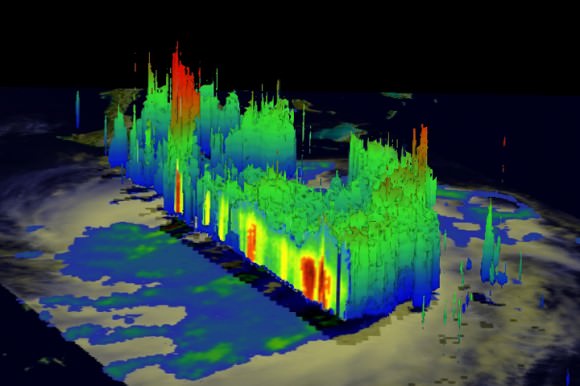
This image was taken on August 22, but is a really nifty, three-dimensional view of the precipitation from Irene, as seen by the Tropical Rainfall Measuring Mission. It reveals an area of deep convection (shown in red) near the storm’s center where precipitation-sized particles are being carried aloft. These tall towers are associated with strong thunderstorms responsible for the area of intense rain near the center of Irene seen in the previous image. They can be a precursor to strengthening as they indicate areas within a storm where vast amounts of heat are being released. This heating, known as latent heating, is what is drives a storm’s circulation and intensification.
Here’s the latest view of Irene from WeatherBug:

As of 8 a.m. EDT on August 25, Hurricane Irene was located near 25.5 N and 76.5 W, or 65 miles east-southeast of Nassau, Bahamas. This places it about 670 miles south of Cape Hatteras, N.C. Irene`s top sustained winds remain at 115 mph, and is moving to the northwest at 13 mph.
Sources: NASA Multimedia,
More Details on the Black Hole that Swallowed a Screaming Star
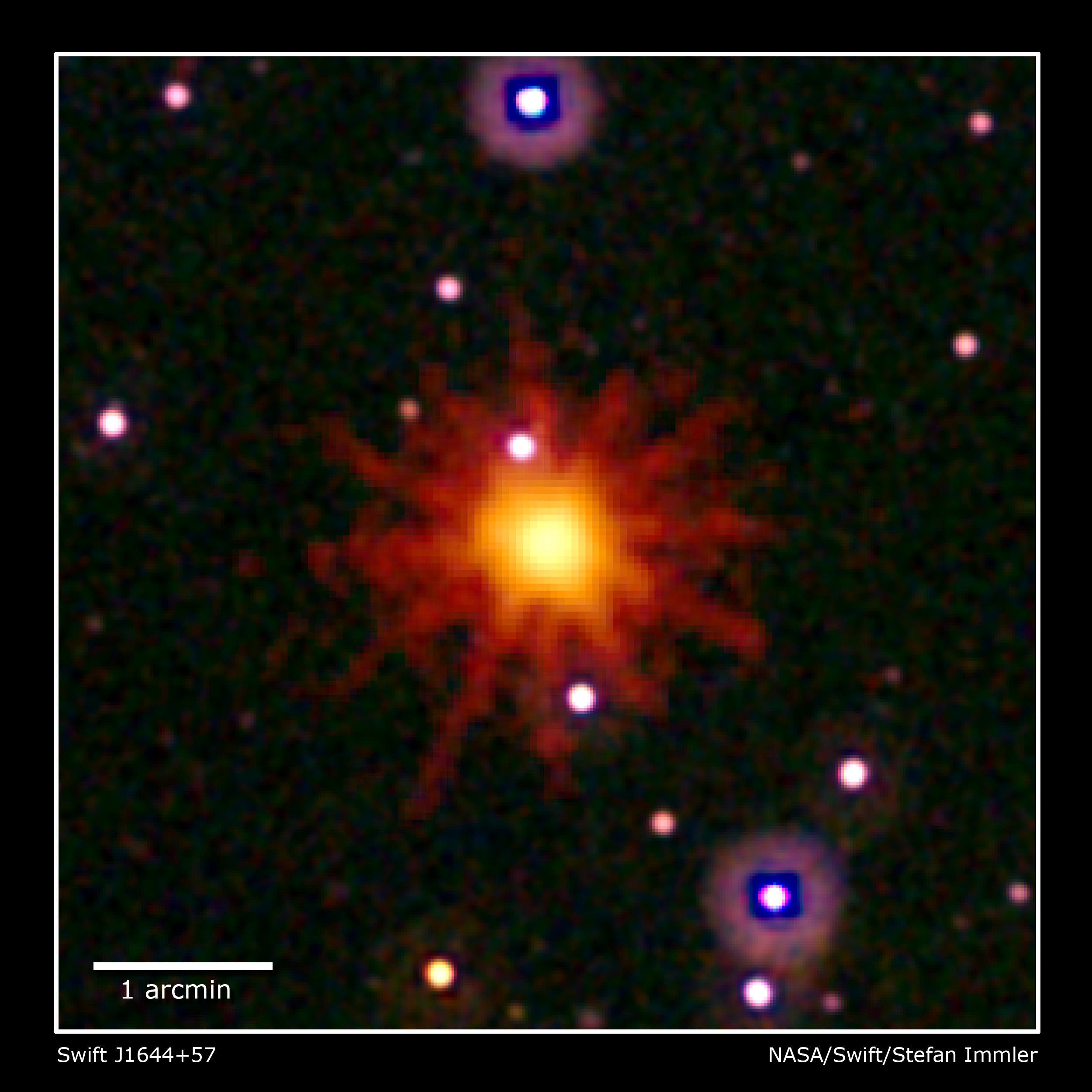
Back in June we reported on the black hole that devoured a star and then hurled the x-ray energy across billions of light years, right at Earth. It was such a spectacular and unprecedented event, that more studies have been done on the source, known as Swift J1644+57, and the folks at the Goddard Space Flight Center mulitmedia team have produced an animation (above) of what the event may have looked like. Two new papers were published yesterday in Nature; one from a group at NASA studying the data from the Swift satellite and the Japanese Monitor of All-sky X-ray Image (MAXI) instrument aboard the International Space Station, and the other from scientists using ground-based observatories.
They have confirmed what happened was the result of a truly extraordinary event — the awakening of a distant galaxy’s dormant black hole as it shredded, sucked and consumed a star, and the X-ray burst was akin to the death screams of the star.
[/caption]
In the new studies, detailed analysis of MAXI and Swift observations revealed this was the first time that a nucleus with no previous X-ray emission had ever suddenly started such activity. The strong X-ray and rapid variation indicated that the X-ray came from a jet that was pointed right at Earth.
“Incredibly, this source is still producing X-rays and may remain bright enough for Swift to observe into next year,” said David Burrows, professor of astronomy at Penn State University and lead scientist for Swift’s X-Ray Telescope instrument. “It behaves unlike anything we’ve seen before.”
The galaxy is so far away, it took the light from the event approximately 3.9 billion years to reach Earth (that distance was updated from the 3.8 billion light years reported in June).
The black hole in the galaxy hosting Swift J1644+57, located in the constellation Draco, may be twice the mass of the four-million-solar-mass black hole in the center of the Milky Way galaxy. As a star falls toward a black hole, it is ripped apart by intense tides. The gas is corralled into a disk that swirls around the black hole and becomes rapidly heated to temperatures of millions of degrees.
The innermost gas in the disk spirals toward the black hole, where rapid motion and magnetism create dual, oppositely directed “funnels” through which some particles may escape. Jets driving matter at velocities greater than 90 percent the speed of light form along the black hole’s spin axis.
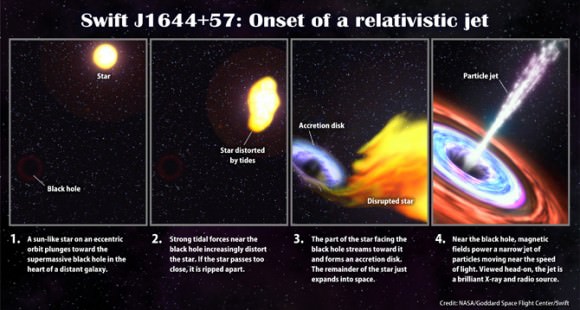
The Swift satellite detected flares from this region back on March 28, 2011, and the flares were initially assumed to signal a gamma-ray burst, one of the nearly daily short blasts of high-energy radiation often associated with the death of a massive star and the birth of a black hole in the distant universe. But as the emission continued to brighten and flare, astronomers realized that the most plausible explanation was the tidal disruption of a sun-like star seen as beamed emission.
“The radio emission occurs when the outgoing jet slams into the interstellar environment, and by contrast, the X-rays arise much closer to the black hole, likely near the base of the jet,” said Ashley Zauderer, from the Harvard-Smithsonian Center for Astrophysics in Cambridge, Mass, lead author of a study of the event from numerous ground-based radio observatories, including the National Radio Astronomy Observatory’s Expanded Very Large Array (EVLA) near Socorro, N.M.
“Our observations show that the radio-emitting region is still expanding at more than half the speed of light,” said Edo Berger, an associate professor of astrophysics at Harvard and a coauthor of the radio paper. “By tracking this expansion backward in time, we can confirm that the outflow formed at the same time as the Swift X-ray source.”
Swift launched in November 2004 and MAXI is mounted on the Japanese Kibo module on the ISS (installed in July 2009) and has been monitoring the whole sky since August 2009.
See more images and animations at the Goddard Space Flight Center Multimedia page.
Sources: Nature, JAXA, NASA

